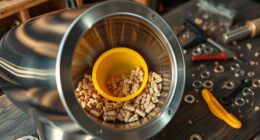To make a chimney cleaning brush from scratch, start by gathering heat-resistant metals like stainless or galvanized steel for the brush body and stiff wire or steel rods for the bristles. Carefully cut and shape the handle using a metal bender or file, then attach the bristles securely with a drill and appropriate fittings. Always prioritize safety, proper tools, and accurate measurements. Keep exploring to learn detailed steps for a durable, efficient chimney cleaning tool.
Key Takeaways
- Select sturdy, heat-resistant steel rods and stiff wire for durable, effective bristles.
- Sketch your brush design, choosing traditional round or custom shapes before cutting materials.
- Use a hacksaw or angle grinder to cut metal components to size, following your design plans.
- Attach wire bristles securely to a metal handle with a drill, ensuring tight and balanced connections.
- Perform safety checks on all fittings, and organize workspace to ensure safe, efficient assembly.

If you want an effective chimney cleaning brush, making one from scratch is a practical and rewarding project. Before diving into the construction, it’s essential to consider safety precautions. Working with tools and materials that can cause injury requires focus and proper handling. Wear safety goggles to protect your eyes from debris, gloves to shield your hands, and a dust mask if you’re working in a dusty environment. Ensuring your workspace is clear of unnecessary clutter also minimizes accidents. Keep a fire extinguisher nearby, just in case, especially when working near flammable materials. Taking these precautions not only keeps you safe but also helps you work more efficiently without distractions.
Next, you need to pay careful attention to tool selection. Picking the right tools makes the process smoother and results in a more effective brush. For cutting and shaping metal, a hacksaw or angle grinder works well, depending on the thickness of the wire or rod you choose. A drill with various bits is essential for attaching bristles or wire loops, and a wrench or pliers will help tighten fittings. If you’re shaping a metal handle, consider a metal bender or file to smooth rough edges. When selecting your tools, opt for quality over price to ensure durability and safety during construction. Having sharp, well-maintained tools reduces the risk of slips or accidents and makes the building process more precise.
When choosing materials, opt for sturdy, heat-resistant metals like stainless steel or galvanized steel for the brush frame and handle. These materials resist rust and withstand high temperatures, ensuring your brush lasts through many cleanings. For the bristles, stiff wire or steel rods are ideal—they need to be firm enough to scrub away soot and creosote effectively. Avoid flimsy or plastic materials, as they won’t hold up over time. Additionally, selecting materials with corrosion resistance can extend the lifespan of your homemade brush. Once you’ve gathered your tools and materials, plan your design carefully. Decide whether you’ll make a traditional round brush or a more specialized shape, and sketch your plan before cutting or assembling.
Throughout the process, maintain focus on safety and proper tool use. Keep your workspace organized, handle sharp tools carefully, and double-check all connections before use. Using the correct tools not only makes the job easier but also ensures your brush is safe and effective. By prioritizing safety precautions and tool selection, you’ll be able to build a chimney cleaning brush that’s both durable and efficient, saving you money and time in the long run. With patience and attention to detail, you can craft a reliable cleaning tool that will serve you well for many chimney seasons ahead.
Frequently Asked Questions
What Safety Precautions Should I Take During the DIY Process?
You should prioritize fire safety by working in a well-ventilated area and keeping a fire extinguisher nearby. Wear protective gloves and goggles to prevent injuries, and make certain your tools are well-maintained to avoid accidents. Keep your workspace clean and organized to prevent tripping hazards. Always handle sharp tools carefully, and double-check your equipment before use. Following these precautions helps protect you and ensures safe tool maintenance during your DIY project.
Which Materials Are Safest for Chimney Brush Bristles?
You should choose fire resistant materials for your chimney brush bristles to guarantee safety during use. Eco friendly bristles, like natural fibers such as tampico or sisal, are also great options because they’re biodegradable and gentle on the environment. Avoid synthetic materials that could melt or produce harmful fumes. By selecting fire resistant, eco friendly bristles, you create a safer, more sustainable chimney cleaning tool that effectively removes soot and creosote buildup.
How Do I Measure Chimney Dimensions Accurately?
To measure chimney dimensions accurately, start by checking the chimney diameter using a flexible tape measure or calipers. Measure the flue length from the chimney opening to the bottom, ensuring you hold the tape straight and snug. Record these measurements carefully. Accurate chimney diameter and flue length make certain your brush fits perfectly, allowing for effective cleaning. Double-check measurements to avoid issues during brush construction or cleaning.
Can I Customize Brush Sizes for Different Chimney Types?
Yes, you can customize brush sizes for different chimney types. To guarantee a proper chimney fitting, measure your chimney accurately and then create custom brush sizes tailored to those dimensions. Adjust the brush diameter and bristle length accordingly, so it cleans effectively without damaging your chimney. Custom brush sizes help you achieve a better fit, making chimney cleaning safer and more efficient.
What Tools Are Essential Besides the Brush Itself?
Besides the brush itself, you’ll need a sturdy ladder, gloves, safety goggles, and a dust mask for chimney cleaning. A chimney brush extension rod helps reach high areas, while a wire brush or scraper can loosen stubborn soot. These tools support effective chimney cleaning techniques and DIY maintenance tips, ensuring safety and efficiency. Always prioritize safety gear to protect yourself during the process and make the job easier.
Conclusion
By making your own chimney cleaning brush, you gain control over the quality and fit, saving money and ensuring safety. Remember, a well-made brush effectively removes creosote buildup, reducing fire hazards. Some believe that homemade tools are less reliable, but with proper materials and craftsmanship, they can outperform store-bought options. Trust your skills and effort—your chimney’s safety depends on it. A DIY approach proves that with knowledge, you can create effective, reliable cleaning tools from scratch.









